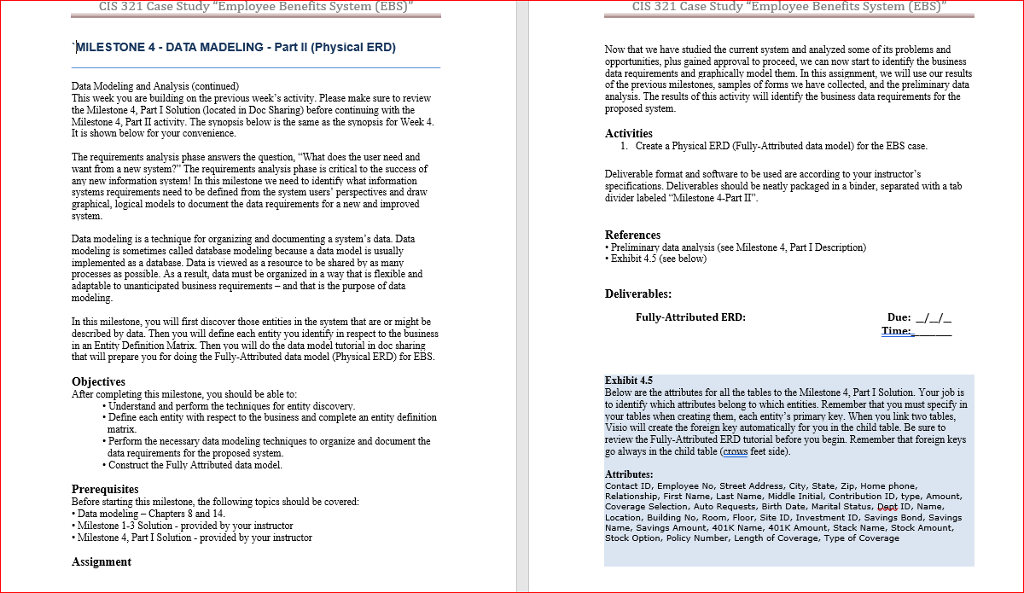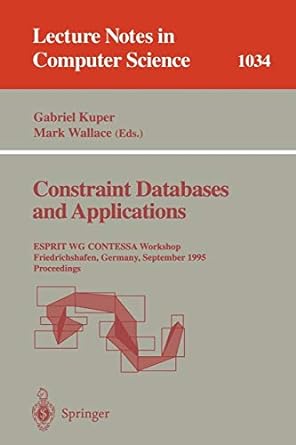I need help with this Please!! It is due.
CIS 321 Case Study "Employee Benefits System (EBS CIS 321 Case Study "Employee Benefits System (EBS MILESTONE 4- DATA MADELING- Part II (Physical ERD) Now that we have studied the current system and analyzed some of its problems and opportunities, plus gained approval to proceed, we can now start to identify the business data requirements and graphically model them. In this assignment, we will use our results of the previous milestones, samples of forms we have collected, and the preliminary data analysis. The results of this activity will identify the business data requirements for the proposed system. Data Modeling and Analysis (continued) This week you are building on the previous week's activity. Please make sure to review the Milestone 4, Part I Solution (located in Doc Sharing) before continuing with the Milestone 4, Part II activity. The symopsis below is the same as the synopsis for Week 4. It is shown below for your convenience. Activities 1. Create a Physical ERD (Fully-Attributed data model) for the EBS case The requirements analysis phase answers the question, "What does the user need and want from a new system?" The requirements analysis phase is critical to the success of any new information system! In this milestone we need to identify what information aystems requirements need to be defined from the system users perspectives and draw graphical, logical models to document the data requirements for a new and improved ystem Deliverable format and software to be used are according to your instructor's specifications. Deliverables should be neatly packaged in a binder, separated with a tab divider labeled "Milestone 4-Part II References Preliminary data analysis (see Milestone 4, Part I Description) Exhibit 4.5 (see below) Data modeling is a technique for organizing and documenting a system's data. Data modeling is sometimes called database modeling because a data model is usually implemented as a database. Data is viewed as a reource to be shared by as many processes as possible. As a result, data must be organized in a way that is flexible and adaptable to unanticipated business requirements - and that is the purpose of data modeling Deliverables: DueI Tim Fully-Attributed ERD: In this milestone, you will first discover those entities in the system that are or might be described by data. Then you will define each entity you identify in respect to the business in an Entity Definition Matrix. Then vou will do the data model tutorial in doc sharins that will prepare you for doing the Fully-Attributed data model (Physical ERD) for EBS. Objectives After completing this milestone, you should be able to: Exhibit 4.5 Understand and perform the techniques for entity discovery Define each entity with respect to the business and complete an entity definition Below are the attributes for all the tables to the Milestone 4, Part I Solution. Your job is to identify which attributes belong to which entities. Remember that you must specify in vour tables when creating them, each entity's primary key. When you link two tables, Visio will create the foreian kev automaticalv for vou in the child table. Be sure to matrix. Perform the necessary data modeling techniques to organize and document the data requirements for the proposed system. Construct the Fully Attributed data model. review the Fully-Attributed ERD tutorial before you begin. Remember that foreign keys go always in the child table (cros feet side). Attributes: Contact ID, Employee No, Street Address, City, State, Zip, Home phone, Relationship, First Name, Last Name, Middle Initial, Contribution ID, type, Amount, Coverage Selection, Auto Requests, Birth Date, Marital Status, Dept ID, Name Location, Building No, Room, Floor, Site ID. Investment ID, Savings Bond, Savings Name, Savings Amount, 401K Name, 401K Amount, Stack Name, Stock Amount, Stock Option, Policy Number, Length of Coverage, Type of Coverage Prerequisites Before starting this milestone, the following topics should be covered: Data modeling- Chapters 3 and 14. Milestone 1-3 Solution - provided by your instructor Milestone 4, Part I Solution - provided by your instructor Assignment CIS 321 Case Study "Employee Benefits System (EBS CIS 321 Case Study "Employee Benefits System (EBS MILESTONE 4- DATA MADELING- Part II (Physical ERD) Now that we have studied the current system and analyzed some of its problems and opportunities, plus gained approval to proceed, we can now start to identify the business data requirements and graphically model them. In this assignment, we will use our results of the previous milestones, samples of forms we have collected, and the preliminary data analysis. The results of this activity will identify the business data requirements for the proposed system. Data Modeling and Analysis (continued) This week you are building on the previous week's activity. Please make sure to review the Milestone 4, Part I Solution (located in Doc Sharing) before continuing with the Milestone 4, Part II activity. The symopsis below is the same as the synopsis for Week 4. It is shown below for your convenience. Activities 1. Create a Physical ERD (Fully-Attributed data model) for the EBS case The requirements analysis phase answers the question, "What does the user need and want from a new system?" The requirements analysis phase is critical to the success of any new information system! In this milestone we need to identify what information aystems requirements need to be defined from the system users perspectives and draw graphical, logical models to document the data requirements for a new and improved ystem Deliverable format and software to be used are according to your instructor's specifications. Deliverables should be neatly packaged in a binder, separated with a tab divider labeled "Milestone 4-Part II References Preliminary data analysis (see Milestone 4, Part I Description) Exhibit 4.5 (see below) Data modeling is a technique for organizing and documenting a system's data. Data modeling is sometimes called database modeling because a data model is usually implemented as a database. Data is viewed as a reource to be shared by as many processes as possible. As a result, data must be organized in a way that is flexible and adaptable to unanticipated business requirements - and that is the purpose of data modeling Deliverables: DueI Tim Fully-Attributed ERD: In this milestone, you will first discover those entities in the system that are or might be described by data. Then you will define each entity you identify in respect to the business in an Entity Definition Matrix. Then vou will do the data model tutorial in doc sharins that will prepare you for doing the Fully-Attributed data model (Physical ERD) for EBS. Objectives After completing this milestone, you should be able to: Exhibit 4.5 Understand and perform the techniques for entity discovery Define each entity with respect to the business and complete an entity definition Below are the attributes for all the tables to the Milestone 4, Part I Solution. Your job is to identify which attributes belong to which entities. Remember that you must specify in vour tables when creating them, each entity's primary key. When you link two tables, Visio will create the foreian kev automaticalv for vou in the child table. Be sure to matrix. Perform the necessary data modeling techniques to organize and document the data requirements for the proposed system. Construct the Fully Attributed data model. review the Fully-Attributed ERD tutorial before you begin. Remember that foreign keys go always in the child table (cros feet side). Attributes: Contact ID, Employee No, Street Address, City, State, Zip, Home phone, Relationship, First Name, Last Name, Middle Initial, Contribution ID, type, Amount, Coverage Selection, Auto Requests, Birth Date, Marital Status, Dept ID, Name Location, Building No, Room, Floor, Site ID. Investment ID, Savings Bond, Savings Name, Savings Amount, 401K Name, 401K Amount, Stack Name, Stock Amount, Stock Option, Policy Number, Length of Coverage, Type of Coverage Prerequisites Before starting this milestone, the following topics should be covered: Data modeling- Chapters 3 and 14. Milestone 1-3 Solution - provided by your instructor Milestone 4, Part I Solution - provided by your instructor Assignment







